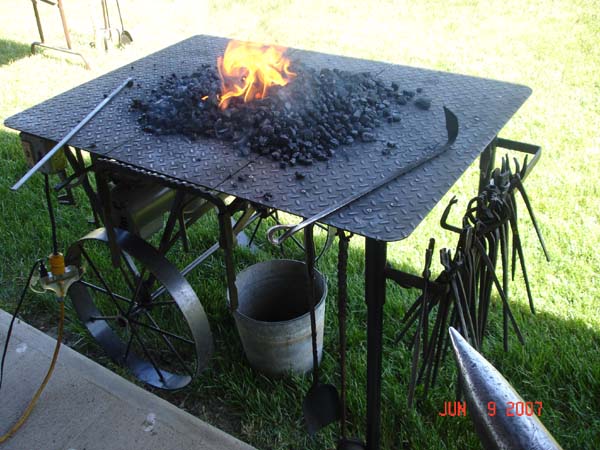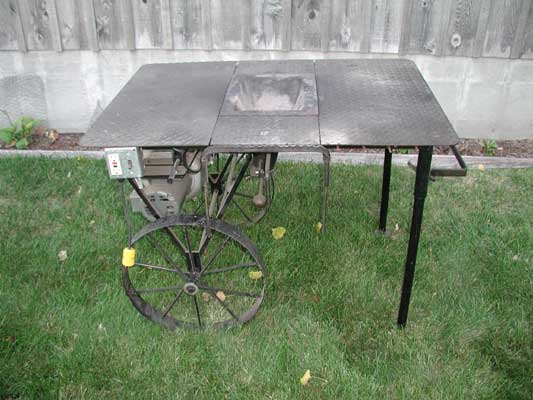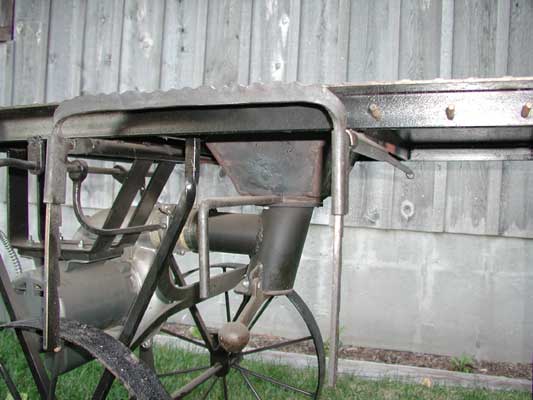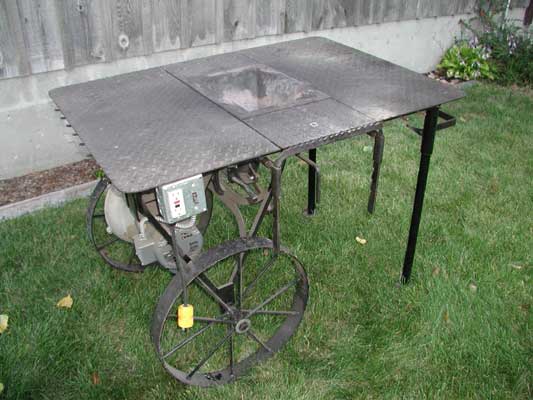Portable Coal Forge




The table is 32” wide and 45” long with the firepot in the center of the table. The table is made of 1/8” steel diamond plate cut into 4 pieces to facilitate placing around the firepot and ease in replacement - the diamonds help keep the coke/coal on the table. The common raised edge often seen around the top of a forging table was purposely left off. Eliminating the raised lip eliminates the possibility of it interfering with iron being heated (this is the same as my permanent forge and an idea derived from seeing Uri Hofi’s forge). The diamond plates are supported by 1 1/2 inch angle iron at the joints and around the edge.
The forge is 32” high. This is the right height for me at 6’ tall. I don’t have to bend my elbow much to pick up a piece of iron and place it on the table - lazy? If it were lower, I’d have to bend my back a little and if it were higher, I’d have to raise my shoulder or bend my elbow more to use it (less strain on the body at the end of the day is the goal).
This portable forge has a homemade firepot (see Fabricated Steel Firepot). The firepot is made of stick welded 1/4 inch mild steel and patterned after the Centaur Forge rectangular firepot. Thicker steel would last longer, but is of course heavier. The firepot is 4 1/2” deep. The inside top of the firepot is 9” wide and 13” long. The firepot has a clinker breaker operated by a horizontal 1/2” round rod with a bend/handle on each end and can therefore be operated from either side of the forge. The firepot has a surplus Centaur Forge ash dumper and a homemade 3” air inlet pipe assembly. The vertical air inlet pipe is set at an angle (see 2nd picture) to help keep clinker from falling into the horizontal air inlet pipe and possibly getting into the fan.
The forge has a PB50vs Centaur Forge www.centaurforge.com electric radial blower (this is one of the few electric forge blowers that has enough pressure to forge weld without flux) with variable speed control. It also has an air gate from Centaur Forge which is used to adjust the air rather than the variable speed control. The variable speed is usually set infrequently at the desired level of air and then the sliding air gate is used frequently to shut off the air and refine adjustment. The sliding air gate is operated by another 1/2” horizontally placed rod directly under the table top which can be reached from either side and pushed or pulled. The air gate slide is attached to the push pull rod by a small forged metal arm. Of course this forge could easily be used with a crank blower instead of an electric blower. Most good old crank blowers have enough pressure to forge weld without flux also if it is cranked fast enough.
There are places to hang tools on the back and also on the sides. The handle on the front also serves to hold tongs.
There is a slide out work/iron support that can be varied in height as well as the distance from the table. The 2 horizontal round rods that hold the support slide in and out inside 2 small pipes welded under the table. The height of the support is adjusted by manually raising or lowering the support and then sliding 2 flattened 2” long pipes (which are loose on the 2 horizontal round rods) into notches in each upright leg of the support. This system for holding the support into position could be improved upon.
The front legs adjust for height for leveling on uneven ground (a pipe inside a pipe with a thumb screw to hold leg in place).
The wheels are 20” in diameter and are from a welding cart, but any large wheels would do. The wheels are placed (front to back) ideally so that there is enough weight on the front of the forge to keep it in place, but not so much weight that it is too heavy to pick up the front handle and move the forge around. Weight of the firepot, fan, and construction determines placement of the wheels for proper balance.

